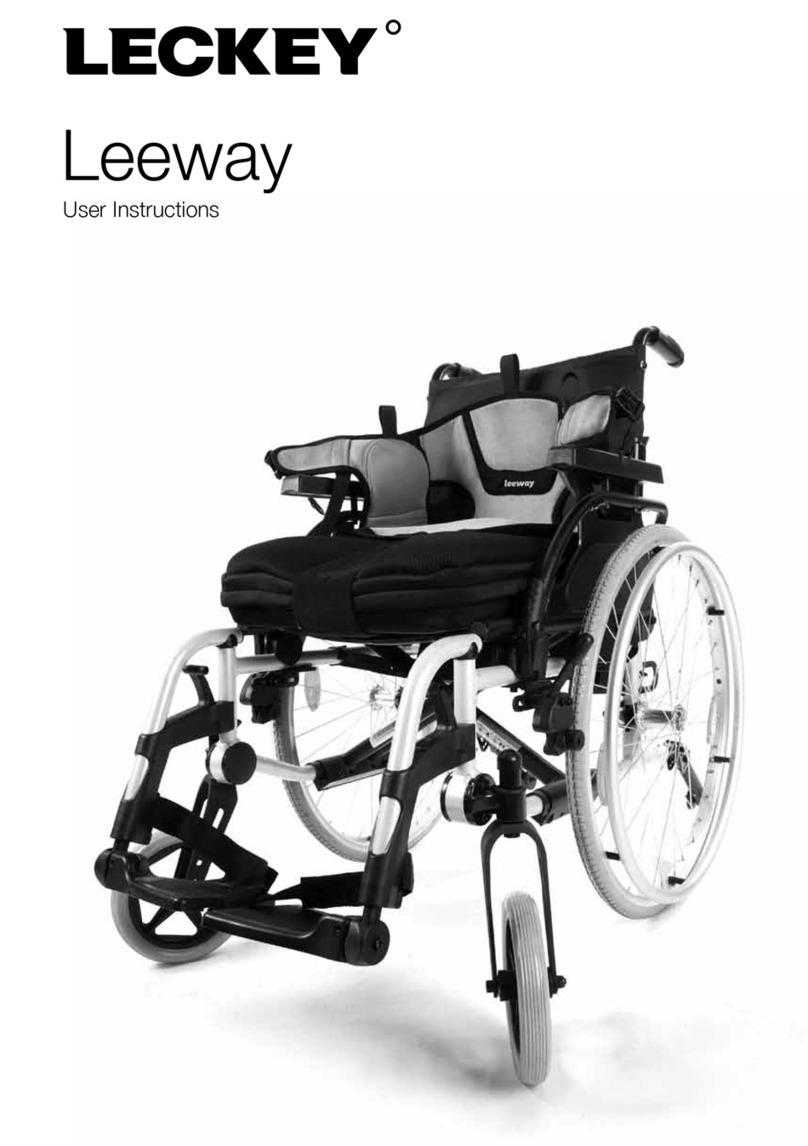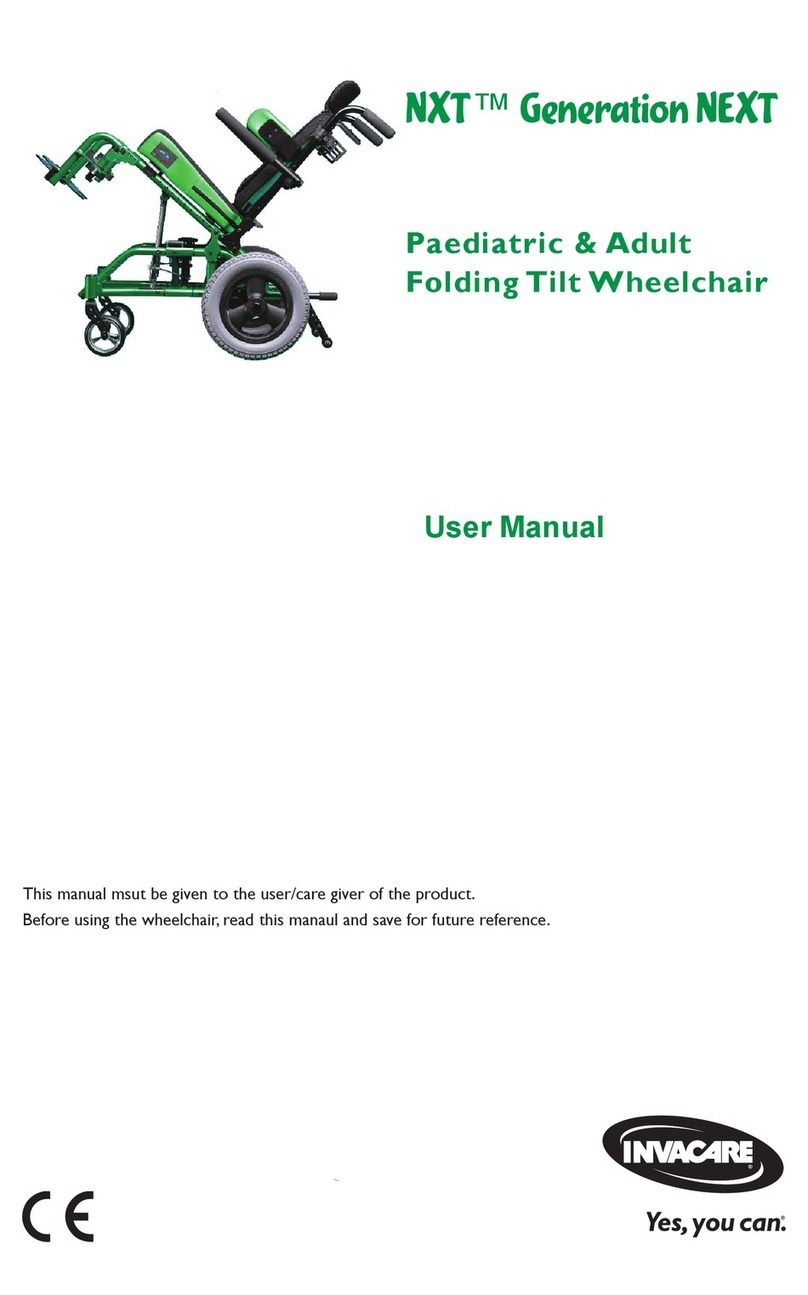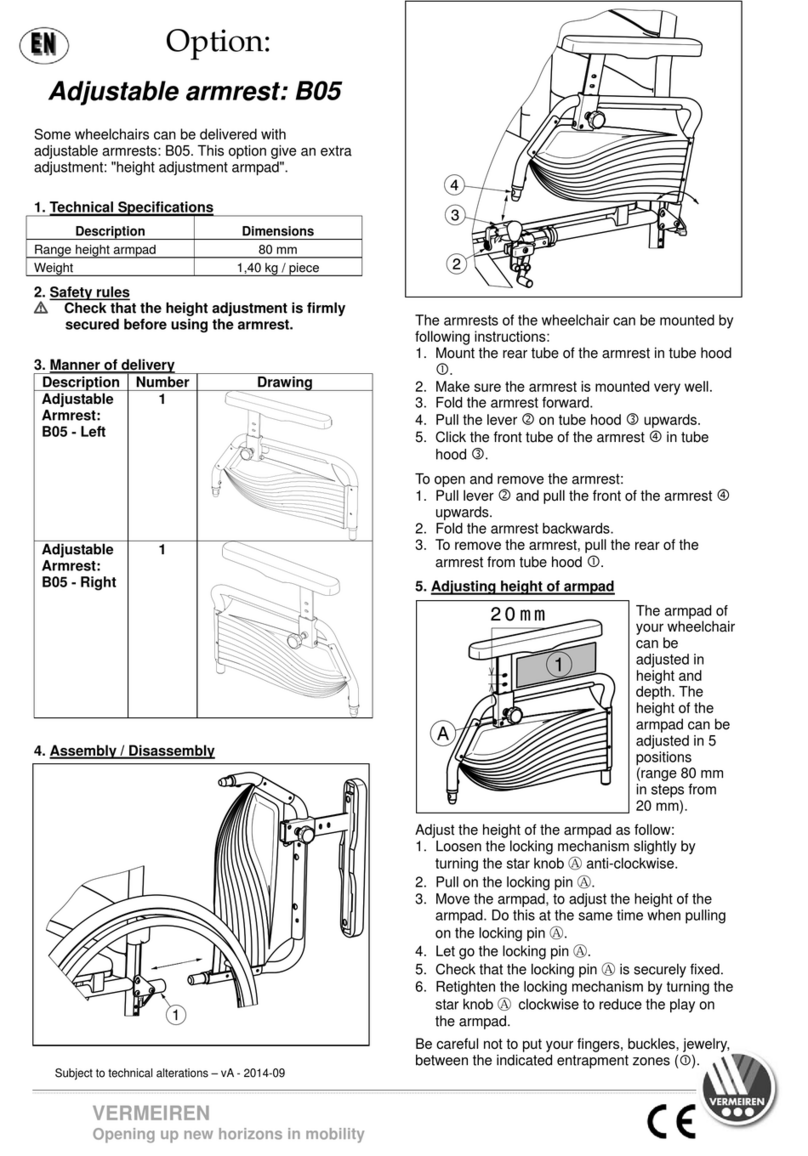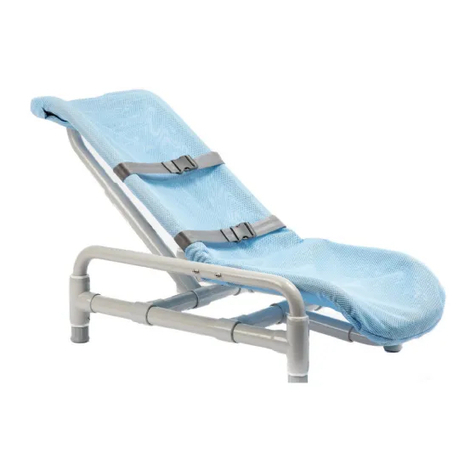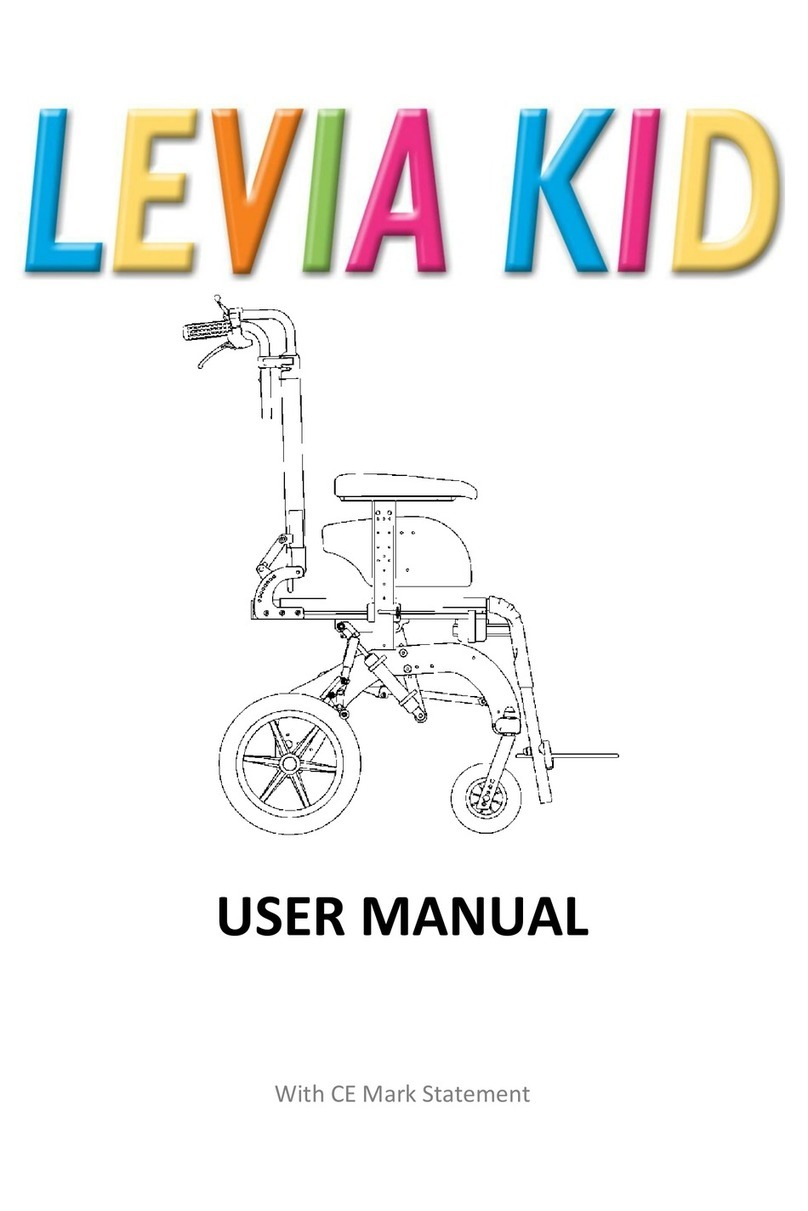I-GO Outlander WC01059 User manual

PAGE 1
CareCo (UK) Ltd, Hubert Road, Brentwood, Essex, CM14 4JE
by
USER MANUAL
PRODUCT CODE: WC01059

PAGE 2
CONTENTS
1. INTRODUCTION
2. IDENTIFICATION OF PARTS
3. SAFETY REGULATIONS
4. SAFETY WARNINGS
5. USER INSTRUCTIONS
6. SPECIFICATIONS
7. COMPONENTS / ADJUSTMENTS
8. TRANSPORTING THE WHEELCHAIR
9. MAINTENANCE
10. CLEANING
11. TROUBLE SHOOTING
12. WARRANTY
1
2
3
3-4
4-5
6
6-9
9
10
11
11
12

PAGE 1
1. INTRODUCTION
Thank you for purchasing the I-Go Outlander. The Outlander is a lightweight
All-terrain wheelchair. The wheelchair is equipped with ergonomic handles so
that your attendant can push the wheelchair with ease and is foldable with
removable components for easy transportation.
Before using your new I-Go Outlander, you must fully read and understand this user
manual.
We want to thank you for the condence in our I-Go products - we pride ourselves on
the quality and reliability of our products.
This user manual contains important information about the safe use and maintenance
of your wheelchair. We recommend you keep this user manual somewhere safe not
only for your reference, but because it is also your proof of warranty. The safety
instructions within are general guidelines, which must be seen as overall guidelines. It
is possible that you develop your own way to make common movements. However, we
advise you to consult a professional for assistance in developing safe and eective
techniques, regarding your daily activities within your physical capabilities.
Your new wheelchair requires frequent maintenance, much of which you can do
yourself. We advise you to take your wheelchair to a professional for a check at least
once a year. You will nd a maintenance schedule further on in this user manual.
We reserve the right without further notice to make any changes to this user manual.
Attention!
In this user manual you will nd tips and warnings. These are clearly identied by the
symbols below.
Tip The tips mentioned in this user manual are designed to make
better use of your I-Go Outlander.
Warning The warnings mentioned in this user manual must always be
followed in order to prevent damage to the I-Go Outlander
wheelchair or injury to yourself.

PAGE 2
2. IDENTIFICATION OF PARTS
Your wheelchair is equipped with various components and parts. You should know
these components and parts before proceeding with the reading of this user manual.
Designs and specications could be changed without further notice.
1
3
7
6
2
8
9
5
4
1. Push handles
2. Backrest
3. Armrests
4. Leg Rests
5. Brake
6. Stepper
7. Rear Wheel
8. Front Wheel
9. Footplates
Parts Description

PAGE 3
3. SAFETY REGULATIONS
4. SAFETY WARNINGS
»I-Go specically disclaims responsibility for any injuries or property damage
which may occur during use when the recommendations and warnings
described in this user manual are not followed. The Outlander is a very safe
and stable product when used correctly, however, it is possible that if you use
the wheelchair incorrectly dangerous situations may occur.
»Protect your wheelchair by checking it regularly. When a part of your I-Go
Outlander doesn’t function correctly, a dangerous situation could occur.
Therefore, you must keep your wheelchair in perfect condition, to ensure safe
use. Periodic inspection, and the correct adjustment and replacement of broken
or worn parts in quick time will result in use for years without any problems.
»When you get your wheelchair, always check if all components are present and if
there is any damage. If components are missing or there is any damage, contact
your I-Go supplier;
»Do not use your wheelchair on streets or roads, only on pavements;
»Do not use your wheelchair on sand, rough or loose surfaces, wet and slippery
surfaces or surfaces with little grip;
»Do not lean on the push handles of the wheelchair, this can result in
it rolling over;
»Never go on or o a kerb without help of your attendant;
»Do not lean or reach out of the wheelchair as this could make you unstable;
»Before getting in or out of the wheelchair, sit back into the wheelchair and face
the castors forward;
»Do not stand on the wheelchair or the footrest - this will cause the wheelchair
to tip and injure the user;
»Place the wheelchair on a stable, at surface before you get in or out;
»Engage the brakes when you use the wheelchair in a lift or on a wheelchair lift
and when you want to get out of the wheelchair;
»If you want to transport your chair we recommend you use a certied tie down
system that is appropriate for your situation;
»While travelling in a vehicle, the wheelchair is not to be used as a seat under any
circumstances as this model has not been crash tested;

PAGE 4
Getting In And Out Of The Wheelchair
Before you get into your wheelchair, you must make sure it’s on a at surface with the
brakes applied and the leg rests ipped sideways. Make sure you are as close as
possible to the wheelchair and the castors are in the forward direction. Now you can,
leaning on the armrests, make the transfer to the wheelchair. To get out of the
wheelchair, follow the above instructions in reverse.
Bending Or Reaching
To reach an object whilst you are in your wheelchair, make sure you are as close as
possible to the object and that the front wheels are facing forwards and the brakes
applied to avoid falling out of the chair.
4. SAFETY WARNINGS
5. USER INSTRUCTIONS
»Never connect anything to the wheels, this may cause damage to the chair and
also eect the balance of the chair and may injure the user;
»Do not push the wheelchair with the brakes engaged. This may cause damage to
the wheelchair and a dangerous situation may occur;
»The maximum user weight capacity has been indicated on your frame
label - do not exceed it;
»The wheelchair is suitable for one person at a time - do not allow multiple
users at once.
Warning
The implementation of structural changes to the I-Go Outlander wheelchair
will invalidate the warranty.

PAGE 5
Going Up Or Down Curbs
To go up a curb, move the wheelchair in a forwards motion, lean your weight forward
in the chair and lift the castors at the front to go up the curb. You can also go up a curb
with an attendant to help - this can be done in 2 ways:
1. Your attendant should place the wheelchair in a forward motion for going up a curb
or threshold. By pressing down on the handles, the castors at the front wheel will
come o the ground. Simultaneously, your attendant should put their foot on the
stepper. This will create a leverage eect so the wheelchair can be pushed up a curb
or threshold.
2. Your attendant should reverse the wheelchair when going up a curb or threshold.
By sitting as far back as possible in the wheelchair and slightly tilting the wheelchair
backwards, your attendant can pull the chair up a curb or threshold. Your attendant
should not lower the wheelchair until the castors are on the curb or threshold.
To go down a curb we recommend this is always done with the help of an attendant.
This should always be done in a backwards motion - your attendant should push your
wheelchair to the edge of the curb or threshold. Now the user has to sit back and the
attendant has to tilt the wheelchair backwards. When the wheelchair is balanced your
attendant can slowly push the wheelchair down a curb or threshold. The wheelchair
should only be pushed further if the castors touch the ground again.
Going Up And Down Inclines
This depends on your physical capabilities and the degree of the incline. When going up
an incline bend your upper body forwards, when going down lean your body back
slightly. If it is necessary you should stop during going up or down the incline, do not
make sudden movements that can cause you to fall over.
5. USER INSTRUCTIONS
Warning
Always be careful when going up and down inclines. An incline steeper than
5 degrees is dangerous for use with this wheelchair.

PAGE 6
6. SPECIFICATIONS
Item
Total Length
(Including foot rests)
Outlander / WC01059
110 cm
Total Width 63 cm
Total Height 96 cm
Total Weight 17 kg
Seat Width 45 cm
Seat Depth 43 cm
Seat Height 49 cm
Back Height 45 cm
Max user weight 135 kg
7. COMPONENTS / ADJUSTMENTS
Folding The Wheelchair
»By folding the foot rests upwards,
the wheelchair will fold to the
smallest width possible. You can
also remove the leg rests entirely
by pulling up on the black lever
and swinging away from the centre
of the wheelchair and lifting up.
»Now you can take hold of the
middle of the seat canvas at the
front and rear of the seat and lift
upwards, causing the wheelchair to
fold. Push the two armrests
together to fold completely.

PAGE 7
7. COMPONENTS / ADJUSTMENTS
Unfolding The Wheelchair
»To unfold the wheelchair, you rst
have to stand in front of the
wheelchair;
»Now, press on the seat tubes
either side of the seat canvas, to
expand the wheelchair as shown in
the image;
»To make sure the wheelchair is
folded correctly, stand in front of
the wheelchair and push the seat
tube as far as it will go;
Armrests
The armrests can be folded backwards by
pushing down the black lever on the arm
rest. To place back again, push the
armrests into the xing point. You are
certain the armrests are mounted well,
when you hear a click.
Black Lever
»Now you can put the foot rests down again and the wheelchair is fully unfolded.
If the leg rests have been removed then these can be re-attached. The leg rests
should be clipped on to the joining bracket at a 90 degree angle and then swung
in towards center. You will hear an audible “click” as these lock into place.
Push Handles
The push handles of your I-Go Outlander are ergonomically designed so that your
attendant has a good grip on the push handles. This design renders the handles
more comfortable and increases safety when being pushed.
Warning Do not lift the full weight of the wheelchair by the push handles.

PAGE 8
7. COMPONENTS / ADJUSTMENTS
Leg Rests
The leg rests of the I-Go Outlander are both foldable and removable. To fold the leg
rests away and take them o, you should follow the steps described below:
»Pull the black lever up to fold the leg rests;
»To take o the leg rests, pull them up at the point where they cannot be
further folded;
»The leg rest is released when it is past the elevations which sit on the
side of the frame;
Black Lever
Footplates
The footplates can be folded - this can be
done simply by pushing upwards or
downwards accordingly. To adjust in
height you will need a spanner.
Warning Do not apply excessive weight to the footplates
»To replace the leg rests, put them over the increases on the side of the frame
and then turn the leg rests in place until you hear a click. This click conrms that
the leg rests are mounted properly.

PAGE 9
Brakes
It is recommended that you apply the brakes when getting in or out of the wheelchair,
as well as when parked. To apply the brakes, push the brake lever forward, away from
you. This can be done when seated or standing.
8. TRANSPORTING THE WHEELCHAIR
Your I-Go Outlander wheelchair is designed to be easily transported by car. Your
wheelchair is foldable so the total width is limited to an average measure of 30-35 cm.
Further your wheelchair is equipped with swing away and detachable footrests, and the
rear wheels are detachable, based on a quick-release system. To fold the wheelchair for
transport, please refer to the above instructions.
7. COMPONENTS / ADJUSTMENTS
Wheels
The Outlander comes with Quick-Release
rear wheels to allow you to quickly
remove these for transportation or
storage. Simply press the button on the
center of the wheel in and pull the wheel
away from the wheelchair frame to slide
them o. Repeat on the other side.

PAGE 10
Preventative maintenance is very important and many of these things you can easily
do yourself (or your attendant). We have highlighted below the maintenance you can
do yourself.
Every week
Check tyre pressure.
Every month
Check the fold ability of the wheelchair;
Check if the quick release rear wheels work properly;
Check upholstery for wear;
Check wheel movement front and rear and check turn ability of the wheels;
Check if the brakes are working correct.
Every three months
Check all bolts, screws and nuts and tighten if necessary;
Check all spokes for tension;
Check tyre tread for wear.
9. MAINTENANCE
Your I-Go Outlander wheelchair needs periodic maintenance. This is necessary for long
and optimum comfort for the user of the wheelchair. A badly maintained wheelchair will
give you more technical problems, make it harder to steer and it won’t be covered by
the warranty. Preventative maintenance is very important. We advise your wheelchair
is checked by a qualied dealer at least once a year. This dealer will replace the relevant
parts where necessary. These annual inspections will make sure your wheelchair will
function correctly for years.
There are a lot of things you can do yourself to keep your wheelchair in optimum
condition. If you regularly check the wheelchair and perform small maintenance tasks,
this will extend the lifetime of your chair and increase the ease of use.

PAGE 11
10. CLEANING
Cleaning your wheelchair is important and should be done regularly. Best procedure for
cleaning is described below:
»Clean the upholstery, chassis and plastic components on the wheelchair
regularly with a mild soap and water. Never use abrasive cleaners, they can
damage the varnish. Also never use steam or high pressure cleaners;
»Wax the varnish of the chassis regularly. Never use solvents, abrasive waxes,
caustic chemicals or spray silicone;
»Dry the wheelchair after cleaning. Also dry your wheelchair after you have
been out in inclement weather.
11. TROUBLESHOOTING
Problems may arise when using your wheelchair. The potential problems that may
occur are described below in the table with solutions. If you have problems with your
wheelchair that cannot be found in the table below, we recommend you to contact an
authorised I-Go dealer.
There is excessive wear on the wheel bearings
The wheelchair squeaks or rattles
The castors utter
The wheelchair moves heavy
The wheelchair is turning slowly
The wheelchairs deviates to the left
The wheelchairs deviates to the right
12345
Problems
Solutions
1 Check if the tyre pressure is correct. Make sure the pressure is equal in both wheels.
2 Check if all nuts and bolts are stuck tightly.
3 The rear wheels and/or castors may be adjusted improperly. Make sure that both rear wheels
and castor are mounted in identical positions.
4 Check if the bearings are not worn.
5 The front fork of the castors may be adjusted improperly. Make sure they are adjusted properly.

PAGE 12
12. WARRANTY
Products are to be t for purpose and of excellent quality and performance. For
valid warranty claims I-GO will, at their discretion, replace / repair / refund items
mutually agreed to be defective.
The wheelchair’s warranty is as follows:
»Frame and durable parts: One year limited warranty
»Warranty Exclusion: The following non-durable items are not
covered by warranty
• Wheel Tyres / Arm Pads
• Seat Cushion
Any damage or defect of any nature occurring from the misuse, abuse of the product,
improper operation or improper storage is not covered. The warranty starts from the
date of arrival of our products.

PAGE 13
NOTES

Table of contents
Other I-GO Wheelchair manuals
Popular Wheelchair manuals by other brands
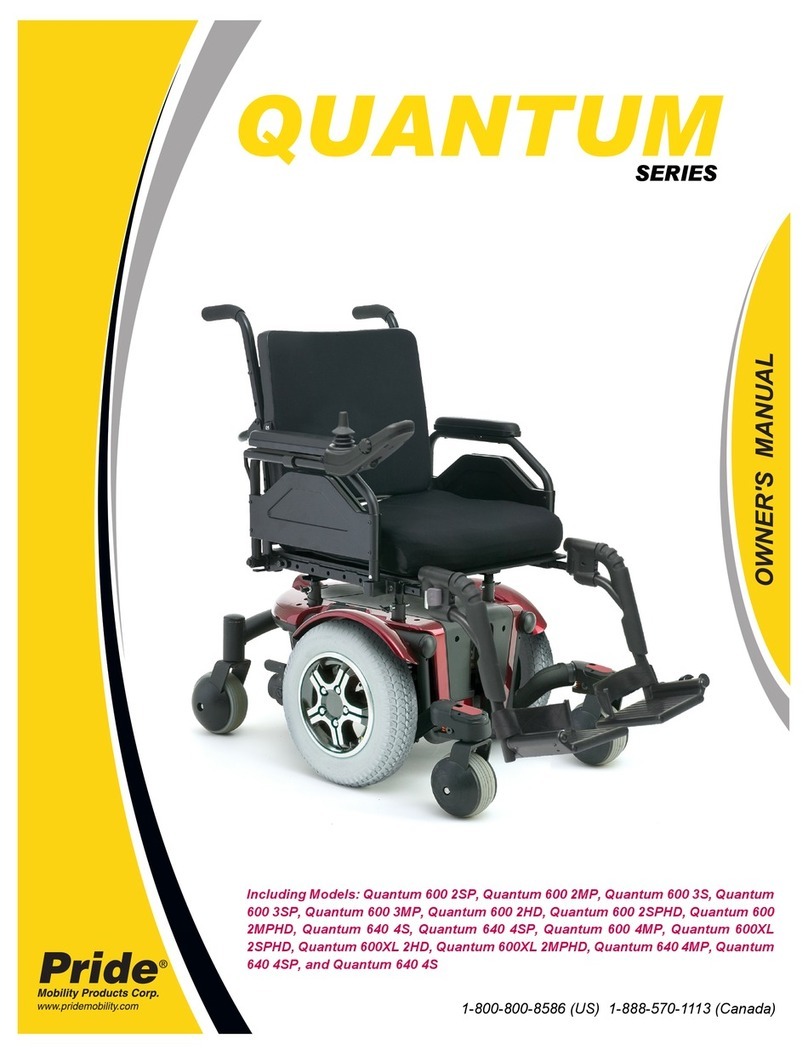
Pride Mobility
Pride Mobility QUANTUM SERIES owner's manual
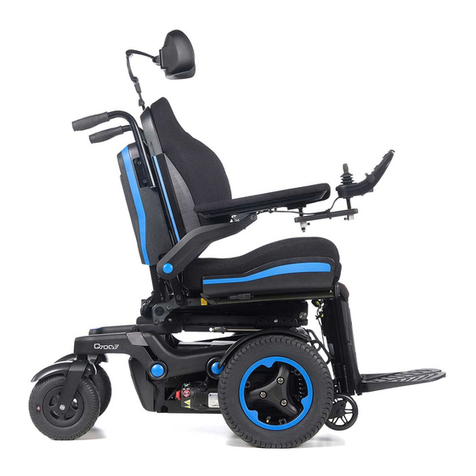
Quickie
Quickie Puma 40 Instructions for use
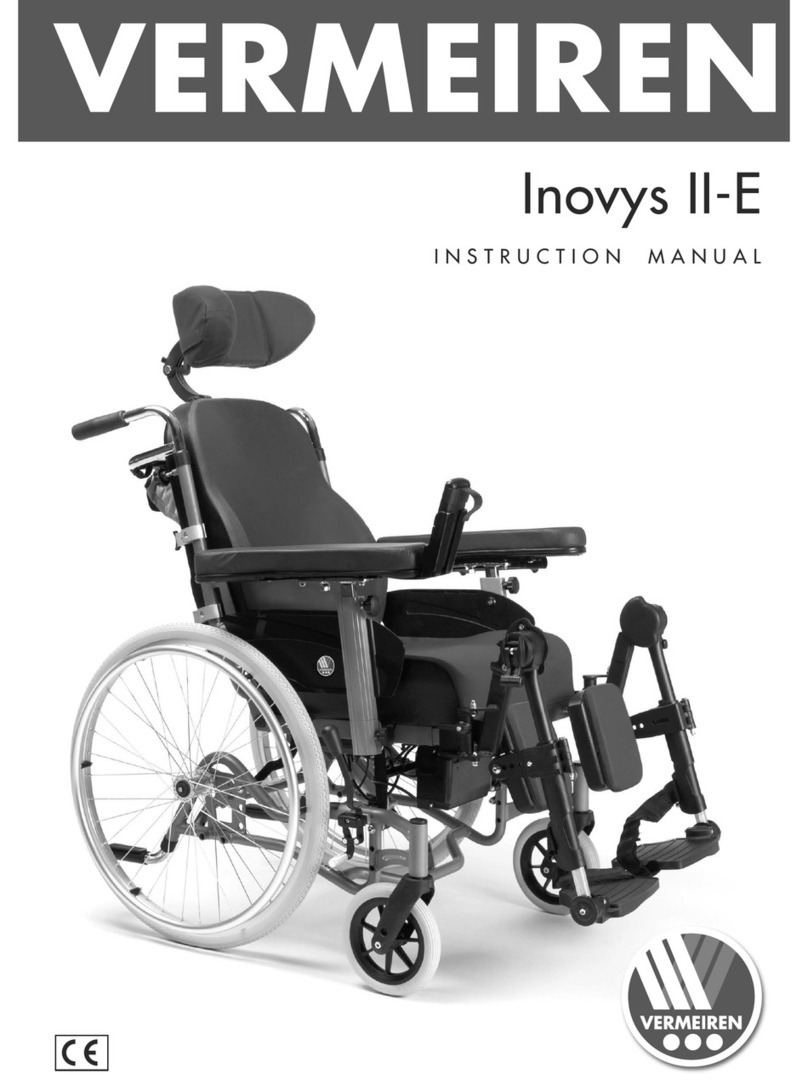
Vermeiren
Vermeiren Inovys II-E instruction manual

Breezy
Breezy Breezy 90 Directions for use
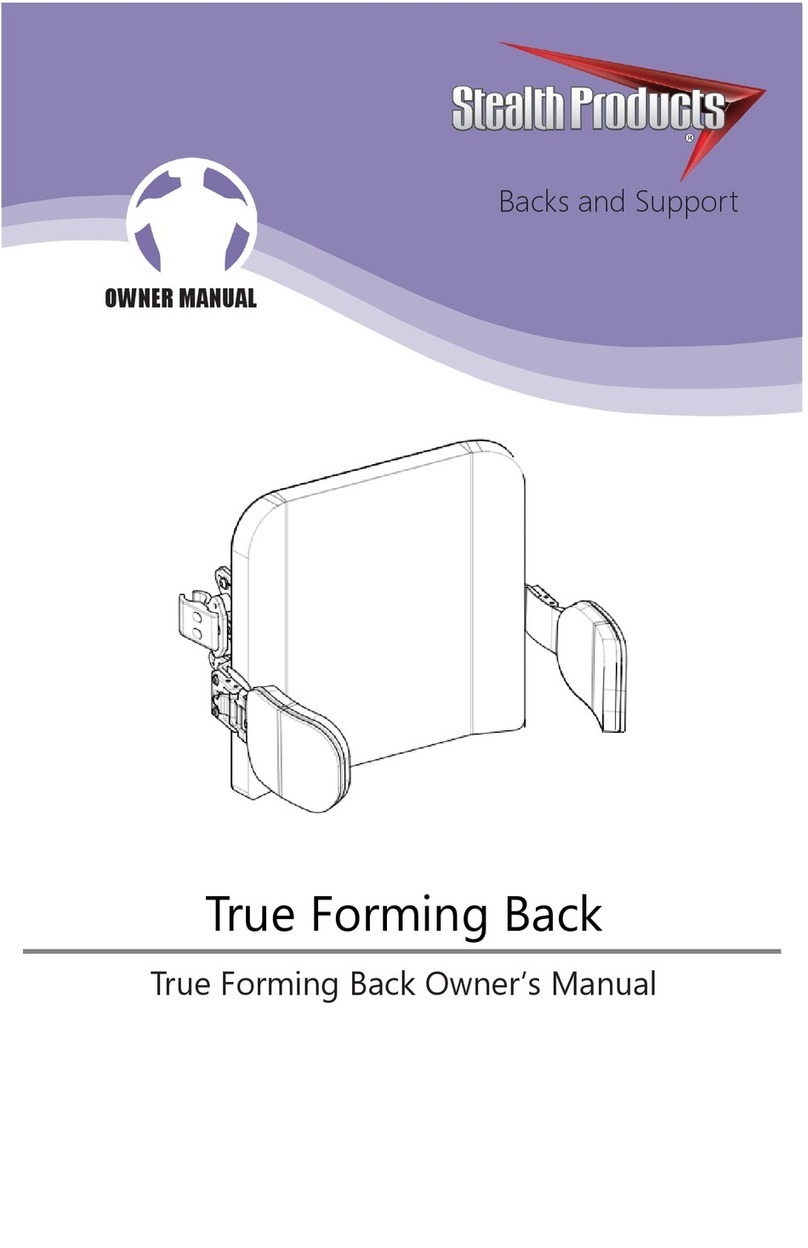
Stealth Products
Stealth Products True Forming Back owner's manual
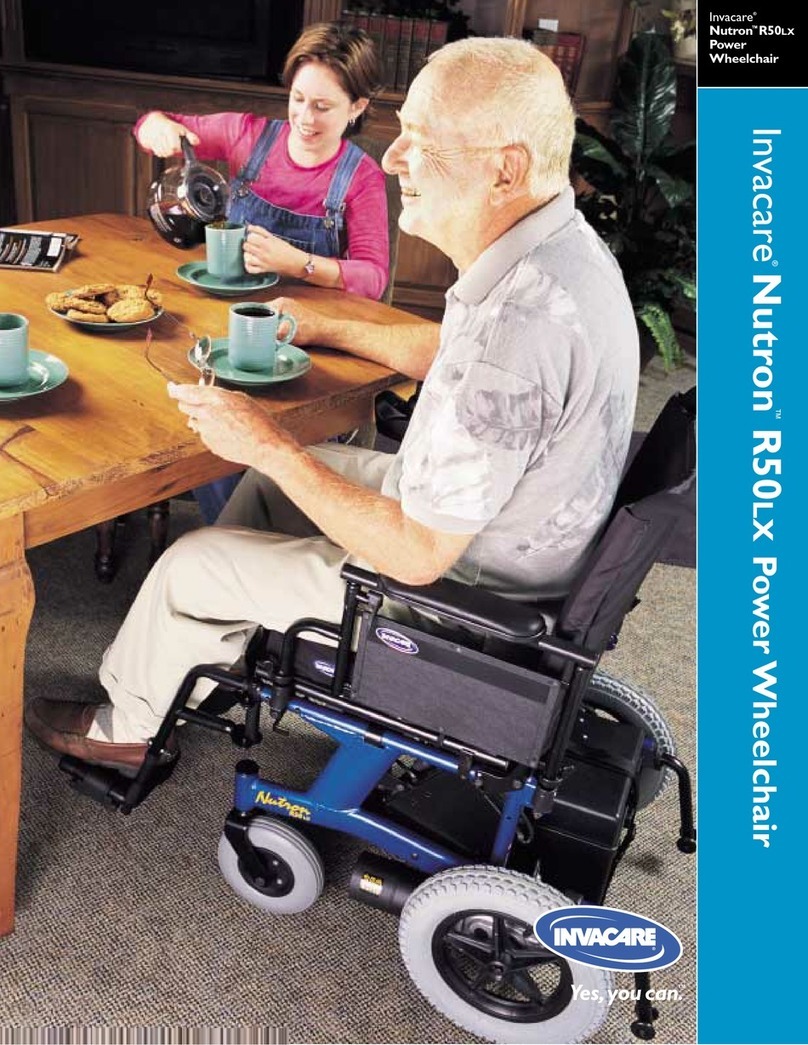
Invacare
Invacare Nutron R50LX Specifications




